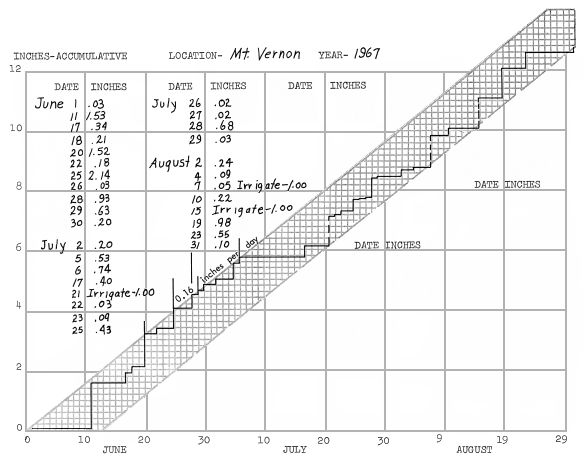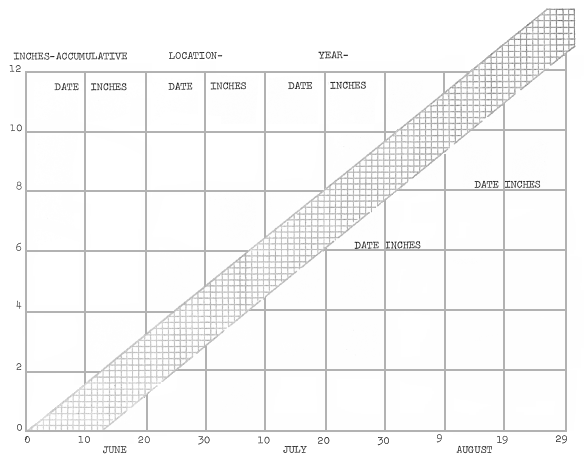| Science and Technology GUIDE Published by the University of Missouri - Columbia Extension Division |
Irrigating Corn on Claypan Soils in MissouriC.M. Woodruff, Department of Agronomy, College of Agriculture The technology of producing corn has progressed to a stage at which yields of 150 bushels per acre and more may be obtained if adequate, but not excessive, water is provided through supplemental irrigation. With populations of 24,000 to 26,000 plants per acre in 30-inch rows, with adequate fertility, with chemical weed and insect control and hybrids suited to high populations, yields in excess of 200 bushels per acre have been obtained using sprinkler type irrigation. The purpose of this Guide is to develop an understanding of the soil moisture conditions desired in a claypan soil, to be used as a guide for irrigating such soils when they are cropped to corn. In irrigating claypan soils there are a number of considerations.
From results of soil moisture investigations under corn, it has become evident that the precipitation requirements of the crop or its best performance is less than its total water requirement for the growing season by the amount of available water stored in the deeper layers of soil. In most growing seasons the average precipitation requirement for the period from June 1 to September 1 may be taken as 0.16 inches per day. To maintain suitable amounts of water in the surface plow depth of soil, the accumulative deficit of precipitation should not exceed 2 inches at any time. Considering that in sub-humid regions, various amounts of precipitation occur at unpredictable intervals, it becomes necessary to chart the accumulation of precipitation and water added as irrigation to keep amounts within prescribed limits. The example chart is for the 1967 season at Mt. Vernon, Missouri.
Accumulative Water Chart as a Suggested Guide for Irrigating Claypan SoilsThe accumulative water chart consists of a solid line with a slope of 0.16 inches per day from June 1 to the last of August. Parallel to this line and two inches below it is a dashed line. For shallow soils and extended hot dry periods a line at a deficit of 1.75 or even 1.50 inches may be more appropriate. And on deep soils in cool seasons deficit of 2.0 inches provides a fair guide for claypan soils within the limits of present experience. To use such a chart the soil profile is assumed to be fully charged with water on the first of June at which time the corn plants normally are too small to ave removed much water from the soil. Records of daily rainfall may be tabulated on the chart as had been done in the sample chart. At the time the amount of precipitation are drawn as a horizontal line from the top of the line for the last day with precipitation. Thus precipitation is accumulated graphically in a stair-step fashion across the chart. If the amount of precipitation gives a vertical line that rises above the upper limit represented byt he solid sloping line, that portion above the sloping line may be interpreted as excess water that would produce runoff. This should be confirmed by observing whether or not the rain caused runoff through ditches and creeks in the vicinity, and a note to this effect entered in the chart. The sample chart suggests that runoff would have occurred on June 20, 25, 28, 29 and July 6. In most instances the soil profile is filled with water while corn plants are small, and sufficient rain to produce runoff will occur some time during the month of June. This establishes the base from which to enter the drier portion of the summer when the needs for irrigation will arise. Following the prolonged wet conditions from June 11 to July 6 there ensued eleven days without rain. A rain of 0.40 inch on July 17 alleviated the immediate need for irrigation, but the maximum deficit of 2 inches to be tolerated was reached four days later on July 21, indicating that supplemental irrigation would be desirable. An application of 1 inch of water on July 21 would have moistened the surface plow depth, yet left space to accumulate as much as one inch of precipitation should rain have occurred immediately after irrigation. With the added irrigation and some showers another irrigation was not indicated until August 6 to 7, and then again on August 14 to 15. The corn growing season of 1967 was very favorable in southwestern Missouri with yields in excess of 100 bushels per acre without the use of irrigation. However, one irrigation of corn on the plots near Asbury, Missouri, in the area resulted in an additional 4 bushels of corn per acre. A summary of past precipitation records for various locations distributed over the entire State of Missouri indicates an average requirement of four irrigations of 1 inch per season based on method of charting irrigation needs that has been described. Thus it is anticipated that measurable benefits will be derived from using supplemental irrigation for growing corn most of the time. The method of charting precipitation as a guide to irrigation as it has been described is offered as a guide to assist those who are undertaking irrigation for the first time. Undoubtedly time and experience will lead to the development of better guides for the purpose. A blank chart is provided. By charting the precipitation even though facilities are not available for irrigating, the needed irrigations may be assumed, thus providing some idea of the extent to which moisture deficiencies develop in a season. When to Cease Irrigation. Since the introduction of this guide in April of 1968 irrigators using it have encountered the need for a suitable means of determining when to cease irrigating as the crop approaches maturity. Results of studies of this problem revealed that applications of water may be terminated when the upper halves of the corn kernels have developed horny or amber endosperms - the mile line has developed halfway down the kernel. At this point the development of the kernel is only five to seven days from complete filling and the soil will contain sufficient available water to complete the process.

 |
[ Contact Joe Henggeler for Questions/Comments ]
[ Woodruff Instructions and Background Information ] [ AgEBB ]
